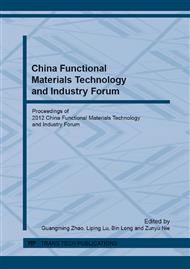[1]
B.Y. Wang, J.H. Zhang and Z.Y. Liu: Fine Chemicals, Vol. 20 (2003) No.6, p.333. (In Chinese)
Google Scholar
[2]
X.H. Li, X.G. Zhang and H.L Li: Chemical Journal of Chinese Universities, Vol. 22 (2001) No.1, p.130. (In Chinese)
Google Scholar
[3]
W.Z. Wang, O.K. Varghese, M. Paulose and C.A. Grimes: J. Mater. Res, Vol. 19 (2004) No.2, p.417.
Google Scholar
[4]
Q. Wang, K. Zhu, N.R. Neale and A.J. Frank: Nano Letters, Vol. 9 (2009) No.2, p.806.
Google Scholar
[5]
Y.J. Zhang, X.F. Li, D. Chen, N.H. Ma, X.S. Hua and H.W. Wang: Scripta Materialia, Vol. 60 (2009), p.543.
Google Scholar
[6]
J.Q. Geng, D. Yang, J.H. Zhu, D,M. Chen and Z.Y. Jiang: Materials Research Bulletin, Vol. 44 (2009), p.146.
Google Scholar
[7]
P. Charoensirithavorn, Y. Ogomi, T. Sagawa, S. Hayase and S. Yoshikawa: Journal of Crystal Growth, Vol. 311 (2009) No.3, p.757.
DOI: 10.1016/j.jcrysgro.2008.09.092
Google Scholar
[8]
T. Kang, A.P. Smith, B.E. Taylor and M.F. Durstock: Nano Letters, Vol. 9 (2009) No.2, p.601.
Google Scholar
[9]
P. Roy, D. Kim, I. Paramasivam and P. Schmuki: Electrochemistry Communications, Vol. 11 (2009) No.5, p.1001.
Google Scholar
[10]
D.W. Gong, C.A. Grimes, O.K. Varghese, W.C. Hu, R.S. Singh, Z. Chen and E.C. Dickey: J. Mater. Res., Vol. 16 (2001) No.12, p.3331.
Google Scholar
[11]
B. O'Regan and M. Gratzel: Nature, Vol. 353 (1991) No.10, p.737.
Google Scholar
[12]
Z.S. Wang, H. Kawauchi, T. Kashima and H. Arakawa: Coordination Chemistry Review, Vol. 248 (2004), p.1381.
Google Scholar
[13]
Q.W. Chen and D.S. Xu: J. Phys. Chem., Vol. 113 (2009), p.6310.
Google Scholar
[14]
S.L. Wei, X. He, F.L. Sun and Z.Y. Zhong: New Chemical Materials, Vol. 36 (2008) No.11, p.91. (In Chinese)
Google Scholar
[15]
Y.K. Lai, L. Sun, J. Zuo and C.J. Lin: Wuli Huaxue Xuebao, Vol. 20 (2004) No.9, p.1063. (In Chinese)
Google Scholar
[16]
H.J. Tao, L. Qin, L. Wang and J. Tao: The Chinese Journal of Nonferrous Metals, Vol. 17 (2007) No.5, p.693. (In Chinese)
Google Scholar
[17]
J. Li, J. Luo and Z.W. Peng: Journal of Inorganic Materials, Vol. 25 (2010) No.5, p.490.
Google Scholar
[18]
E.Hendry, M. Korberg, B. O'Regan and M. Bonn: Nano Letters, Vol. 6 (2006) No.4, p.755.
Google Scholar


